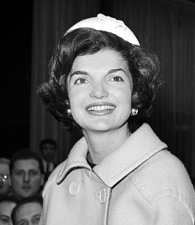Happy Birthday, Jacqueline Kennedy Onassis, Fashion Icon and First Lady

Jackie Kennedy’s Early Days
Kennedy’s Life as First Lady
Sources in this Story
- National First Ladies’ Library: Jackie Kennedy
- Encyclopedia Britannica:Jacqueline Kennedy Onassis
- The White House:Biography of Jacqueline Kennedy
- The New York Times:Death of a First Lady: Jacqueline Kennedy Onassis Dies of Cancer at 64
- The Museum of Broadcast Communication: Tour of the White House with Mrs. John F. Kennedy
- PBS: Lady Bird Johnson:The Assassination of President Kennedy
- Time: A Profile in Courage
- JFK Lancer: Kennedy Assassination Chronicles (PDF)
Her New York Times obituary notes that the new first lady brought class and charm to the Kennedy presidency, with “the whispering, intimate quality of her voice … the bouffant hair and formal smile for the Rose Garden and the barefoot romp with her children on a Cape Cod beach.”
She did more traveling than any previous first lady, visiting more than a dozen countries. She also established the White House Historical Association and through donations she retrieved furnishings belonging to James Madison, Ulysses S. Grant and Abraham Lincoln.
On Feb. 14, 1962, she led a tour of the restored White House on CBS, which was watched by three out of every four Americans, according to the Museum of Broadcast Communications.
On Nov. 22, 1963, President Kennedy was assassinated while sitting next to Jackie in an open car in Dallas, Texas.
That day, Lady Bird Johnson, wife of new President Lyndon Johnson, wrote in her diary, “You always think of someone like her as being insulated, protected. She was quite alone. I don’t think I ever saw someone so much alone in my life.” At the funeral, the new first lady admired the former’s strength: “Maybe it was a combination of great breeding, great discipline, great character. I only know it was great.”
The Rest of the Story
After Aristotle Onassis died in 1975, “Instead of endorsing a cause, as many ex-First Ladies and underemployed princesses have done, she took a job,” wrote Martha Duffy for Time magazine. She worked as a book editor for 18 years.
In the mid-80s, she and Maurice Templesman, a financier from Belgium and an acquaintance of JFK, became companions and eventually lived together on Fifth Avenue until her death from cancer on May 19, 1994. Days before she died, Jackie returned home, believing further treatment was pointless. John Kennedy Jr. said, “She did it in her own way and in her own terms.”
After her death, notes from the December 1963 “Camelot interview” with Life magazine journalist Theodore White were released. White wrote in his memoir how he’d set aside his own journalistic integrity at Mrs. Kennedy’s urging, to, in her words, “rescue Jack from all these ‘bitter people’ who were going to write about him in history.”